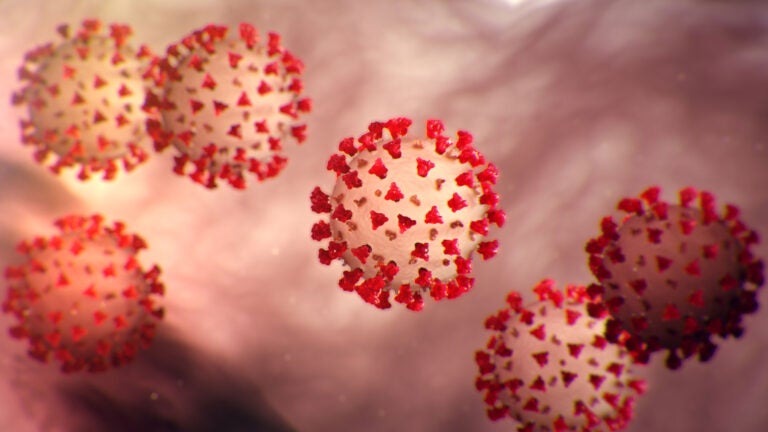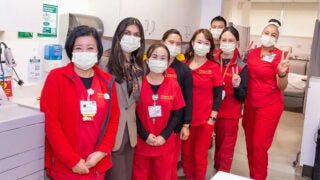
SARS-CoV-2, the virus that causes COVID-19 (Illustration/Centers for Disease Control and Prevention)
Relief in sight as COVID-19 winter surge tapers at USC and in L.A. County
USC Student Health’s Sarah Van Orman credits masking, surveillance testing and high vaccination and booster rates with keeping the community safe.
The COVID-19 omicron variant — which went from newly detected to widespread transmission seemingly overnight — is showing a decline, both in Los Angeles County and at USC.
“We are relieved to have passed the peak of this winter surge,” said Sarah Van Orman, chief health officer for USC Student Health.
As the campus emptied for the Thanksgiving weekend, the pandemic took an unexpected turn on Nov. 26 when news of the fast-moving omicron variant broke across the globe.
Over the next 11 days, the variant was confirmed in the U.S. with a first case discovered in California, then in Los Angeles County, and then confirmed at USC.
USC COVID positivity rate jumped around the holidays
The highly transmissible variant quickly took hold across the U.S., and within weeks became the dominant strain that helped fuel a winter surge. In L.A. County, the surge hit its peak at more than 41,000 new cases in a single day on Jan. 16. At USC, the positivity rate among students jumped from less than 1% to nearly 10% in a two-week span from when the variant was first confirmed on Dec. 6 to shortly before the end of the fall semester (the week ending Dec. 20).
The campus “pop testing” program — PCR testing that was required weekly for all students, and every 72 hours for individuals who are unvaccinated with approved exemption — reached its peak in test positivity of about 13% in the weeks just prior to and just after New Year’s celebrations. At the peak during the week on Jan. 8, more than 2,100 student positive cases were under management at USC Student Health, with 346 employee cases also recorded.
Welcome declines in USC COVID numbers
Now those numbers are showing welcome declines.
“It is fortunate that we have had more tools in place than in last year’s respiratory season, including the vaccines and the booster doses,” Van Orman said. “Our campus community has been incredibly consistent in masking and participating in the surveillance testing, which has helped prevent additional community spread. High rates of vaccination and the booster have protected our community from severe disease.”
Adjusting to the unexpected is how we have to move forward.
Sarah Van Orman, USC Student Health
chief health officer
The “pop testing” (surveillance testing) program at USC Student Health is expected to reach the 1 million mark of tests administered within the next week. Testing began on March 13, 2020, and has been the cornerstone of the university’s prevention strategy, along with symptom checks, community education on hygiene and safety, isolation and quarantine operations, environmental mitigations, indoor masking and wastewater testing. The availability and widespread adoption of vaccines — 95% among all campus populations — and later, boosters, greatly enhanced the campus’s ability to prevent further spread and illness.
“Adjusting to the unexpected is how we have to move forward,” Van Orman added. “At the beginning of this surge, the data modeling helped us understand the trajectory of cases, and plan for a reasonable response in terms of remote start, planning for isolation space, and other measures. As the virus evolves, our responses have to continue to be adaptive as well.”



